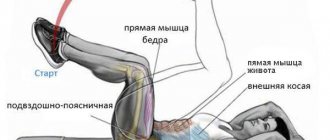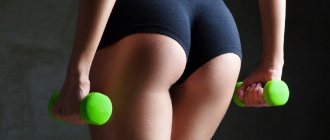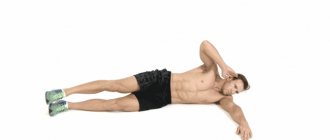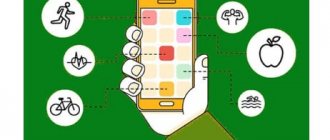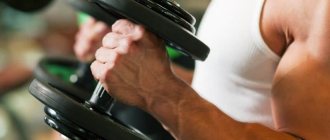The external obliques are made up of three muscle layers: the internal obliques, transverse obliques, and external obliques.
The force vector of each layer has its own direction.
With joint efforts, they tilt the body to the sides and rotate it around its axis. Unlike the rectus abdominis, the obliques respond very quickly to high-weight, low-repetition exercises. They become massive and make the waist excessively wide. That is why these muscles need to be trained exclusively with light weights, doing at least 50-70 repetitions per set. Indirect load when turning the body falls on the intercostal muscles. This muscle group will work especially productively when lifting the body from a horizontal position with a turn. Since the main function of the intercostal muscles is to ensure exhalation and bring the ribs closer together, this exercise should be performed after exhaling strongly. The serratus anterior muscles experience direct impact only in the following exercise.
You kneel down and grab the handle of the block above your head with your hands. With your elbows slightly bent, you try to “press” the handle of the block to the floor with straight arms. It is clear that you have to do this by force of your torso tilted towards the floor. In this tilt, the serratus anterior muscles work with maximum load. So, even the most superficial description of the abdominal muscles leads to the conclusion that the abdominal complex should include a variety of exercises.
Here are the exercise options that your complex should consist of:
Pros and cons of Russian crunches
Pros of the exercise:
- Thanks to the peculiarities of the technique, the exercise trains not only the external abdominal muscles, but also the internal ones, which are responsible for maintaining the spine and the correct position and functioning of the internal organs. Relaxed internal abdominal muscles cannot hold the lower back in the correct position, which causes lumbar hyperlordosis to form.
- The exercise, when performed in large numbers of repetitions, forms a muscle corset, visually improves the shape of the muscles and indirectly helps to reduce waist size, especially with the right loads and nutrition. Exercise itself does not burn fat locally in this area. And lifting weights makes the muscles thicker and more defined.
The disadvantage of the twist is that the oblique twisting technique is not suitable for everyone, namely for problems with the spine - hernia, protrusion, pinched nerve endings, osteochondrosis and displacement of the vertebrae. Even in healthy people, performing a twist incorrectly can cause back pain. Therefore, it should be performed with good physical preparation and master the technique first without weights.
It is very rare to find people who truly effectively train their abs. Unfortunately, novice bodybuilders are not attracted to heavy exercises: squats with a barbell, pull-ups with weights, deadlifts. As a rule, they prefer fashionable, expensive and, according to trainers, “very effective” exercise machines, having absolutely no idea what muscles are being stressed and why.
Namely, basic heavy exercises build strength and muscle mass. Remember Steve Reeves, Vince Gironda and other famous athletes of the last century. They did not have the opportunity to train with state-of-the-art equipment. However, the abs of the bodybuilders of those times may be the envy of many of their successors.
If you take the trouble to study the structure of the abdominal muscles in an anatomy textbook, you will be surprised at how complex it is. Here are the rectus abdominis, external oblique, intercostal, and serratus anterior muscles. Most bodybuilders understand the task of pumping up the abs in a very primitive way and do thousands of body lifts, considering this exercise to be the most effective. In fact, when lifting the body from a horizontal position, only the rectus muscles work, and then only in the first third of the amplitude of movement. Next, the torso is lifted by the thigh and lumbar muscles. The external obliques are made up of three muscle layers: the internal obliques, transverse obliques, and external obliques. The force vector of each layer has its own direction.
With joint efforts, they tilt the body to the sides and rotate it around its axis. Unlike the rectus abdominis, the obliques respond very quickly to high-weight, low-repetition exercises. They become massive and make the waist excessively wide.
In most cases, the result of an unsightly abdomen and a problem with pumping up the abs is not the small size of the abdominal muscles, but the fat layer that is located in front of them. The rhythmic (aerobic) style of training has an excellent cardio effect and stimulates fat burning. Cardio training should last no more than 30 minutes. Do it 1 to 3 times a week 8 to 12 hours before or after strength training.
Nutrition also plays a big role in fat loss. Determine your daily calorie needs and weekly reduce the number of calories you consume per day by 100 - 150 below the previous week. Do not limit salt in your diet, drink more clean water.
No matter what anyone says, the abdominal muscles are “prepared” in the kitchen. If you want to have pumped up abs, then 90% of this is due to a strict diet and only 10% of this depends on physical exercise. You can have the best exercise routine in the world, but if you have a layer of fat on your belly, no one will notice. Therefore, the first thing you need to realize is that proper diet is the single most important factor. There is no other way, unless you are the lucky owner of good genetics that allows you to eat whatever you want and not gain weight.
Examples of ideal abs can be seen in Lazar Angelov or fitness model Zyzz (Aziz Shavershyan).
01.Raising the torso on a vertical bench
This exercise is quite effective for working the rectus abdominis muscles. At the same time, it uses, but to a lesser extent, the oblique abdominal muscles.
The first thing to do is to take the correct starting position. To do this, you need to sit on an inclined bench, fix your feet under the bolsters, and place your arms (but not in a lock) above your head or you can simply cross them over your chest.
The hip flexors in this variant take very little part as synergists, so the load on the rectus abdominis muscle is close to the maximum.
And the vertical position of the body creates conditions for very intense muscle contraction at the end of the movement.
The exercise requires sufficient physical strength, which beginners can gain by starting with easier variations.
02. Raises of the torso against the gymnastic wall
To perform this abdominal exercise, you need to lie down near a wall bars and fix your feet between the bars, as shown in the photo. Bent legs should form a right angle. Inhale and raise your torso as high as possible, rounding your back, then return to the starting position. At the end of the movement, exhale.
You need to start with the correct starting position: lower your torso to the floor, bend your legs, hooking your feet to one of the bars of the wall bars so that your hips are vertical, hold your hands behind your head (it is advisable not to make any effort with your hands to raise your head if it is difficult for you not to help with your hands. Take a towel and place it under your head, holding the ends of the towel, smoothly lift your torso off the floor, rise until your shoulder blades come off the floor).
This exercise works the rectus abdominis and, to a lesser extent, the internal and external obliques. If you move your torso away from the wall bars and place your feet lower, this will allow you to make movements of greater amplitude and engage the hip flexors.
03. Raising the body with rotation
During this exercise, the entire part of the abdominal wall is involved (primarily this concerns the upper half of the entire complex). If done wisely and correctly, the result will be obvious.
Take the starting position: lying with your back on a bench designed specifically for working out the abdominals, hook your feet onto a strap or rotating pillows. The legs should be positioned at an angle of 30 degrees (this position does not change until the end of the exercise) - this will significantly reduce dangerous tension in the back, namely its lower part. The palms should be at the temples.
Raise your body, alternately turning left and right at the top point of the lift, return to the starting position. The rectus, intercostal and oblique abdominal muscles and the anterior surface of the thigh muscles are worked out.
To maximally load the upper abdominal muscles, keep your hands behind your head, and try to spread your elbows to the sides. Placing your hands behind your back or crossing your chest will make the exercise easier.
The load can also be increased by changing the angle of the bench or placing a weight on the chest.
04. Leg raises while lying on an incline bench
The main goal of this exercise is to work out the muscle complex of the lower abdomen and the hip flexor muscles. Even a beginner can handle this exercise without any problems.
You lie upside down, while the entire surface of the abdominal press is trained. The lower back is pressed against the board, the range of motion is short, the legs are bent at the knees and do not fall completely at the lowest point. There is no need to touch your chest with your knees at the top point. Breathing plays an important role in this exercise. When raising your legs and squeezing your abdominal cavity, exhale; when lowering your legs, take a deep breath.
With all leg raises, you need to tuck your chin to your chest to tighten your upper abdomen.
Do not lower your feet at the bottom of the movement onto the bench until the end of the exercise, otherwise the load on the abdominal press will decrease.
Holding your breath while lifting your legs allows you to tighten your abdominal muscles more, which increases the effectiveness of the exercise and reduces the likelihood of spinal injury.
05. Crunches with legs raised
Lie on your back, while pressing your lower back slightly to the floor. The arms must be straightened along the body. When performing the exercise, cross your legs at the ankles. Now slowly raise them to the level until your thighs are strictly perpendicular to the floors.
Cross your arms across your chest. This is your starting position.
While continuing to hold your lower back in the original position, as you exhale, you need to lift your upper body, thereby performing a twist. As you inhale, smoothly return to the starting position.
06. Raising the torso on an incline bench
By performing this exercise, you will use the middle and upper abs to a greater extent and, to a lesser extent, the obliques and lower abs.
In order for the main part of the load to fall on the oblique abdominal muscles, simply alternately rotate your torso in different directions. That is, when turning the body to the left side, the left internal and right external oblique abdominal muscles and, together with them, the rectus abdominis muscle are included in the work.
When performing exercises, try to concentrate your attention on muscle sensation. By the way, for this you do not need to increase the inclination of the bench very much.
Sitting on an incline bench, feet under bolsters, hands behind your head or on your hips, and knees bent to relieve stress on your lower back. Inhale and tilt your torso about 20-50 degrees (the degree of the exercise is needed to regulate the tension on the muscles), lowering your torso back, hunching your back, as if laying your lower back on a bench, to concentrate the tension on the rectus abdominis muscles (the head should be lower than the legs ). Do not touch your back to the bench to avoid complete muscle relaxation. Exhale at the end of the movement (with maximum noticeable load on the muscles). Raise your torso and try to reach your chin to your knees.
The load can also be increased by changing the angle of the bench or placing a weight on the chest. Alternatively, the exercise can be performed on the floor. To do this, bend your knees and fix your feet.
07. Side bends with a dumbbell in hand
This exercise is quite effective for working the abdominals. It helps to increase his strength. All you need in terms of equipment is just a dumbbell. Even an inexperienced beginner athlete can cope with this exercise.
Stand straight, holding a dumbbell in your left hand (palm facing your torso), your right hand resting on your waist. Feet - shoulder width apart. This is the starting position. Keeping your back straight and your head raised, while inhaling, bend to the right as low as you can. Hold for a second and exhale as you return to the starting position. Note: the bend is performed only at the waist, the rest of the body remains motionless. Now tilt to the left in the same way. Hold for a second and return to the starting position.
You can also do this exercise sitting on a bench and use a barbell instead of a dumbbell.
08. Crunches on the upper block
Crunches on the upper block are an excellent exercise for the comprehensive development of all abdominal muscles. A peculiarity of performing crunches on a block is the participation in the movement of not only superficial muscle groups (rectus and oblique abdominal muscles), but also internal (transverse muscles). This is especially important when practicing various types of martial arts - the transverse muscles protect the internal organs from enemy blows to the body.
In addition, unlike standard sit-ups, this twisting option does not put strain on the lower back and is more comfortable.
Hold the handle in the way that is most comfortable for you - behind or directly above your head. If you use a rope, then its ends can be held on the sides of the neck. Using a rope allows you to easily do the exercise with your back turned to the rope, and this is the option that gives the best effect.
The more you bend your arms, the more stress you will feel in your elbows. If this exercise begins to lead to a feeling of discomfort/pain in the elbow joints, then change the angle of flexion in them.
Keep your knees less than 90 degrees. Keep your pelvis and lower back still. From a starting position where your spine is perpendicular to the floor or slightly tilted forward, begin to flex (“twist”) your spine until your upper back is close to horizontal. Do all repetitions fairly slowly to maintain constant tension in the muscles. Never try to put so much weight on the machine that you simply have to lean all your weight on the cable just to lift the weight that is too heavy for you. Remember that you must “twist” your spine at a certain amplitude, and not just pull the cable. Exhale as you twist, then hold the position of maximum muscle contraction for a second before slowly returning to the top position.
Avoid bending forward with a straight back (this is a slightly different exercise); instead, “twist” your body by contracting your abdominal muscles.
Russian floor crunch technique
- Starting position: sitting on your buttocks, keep your feet hanging, bending your knees. Lean your body back about 45 degrees, slightly rounding your back. Stretch your arms in front of you, placing your palms together for comfort. This position should be maintained throughout the approach. The main thing is not to lose your balance.
- In the center of the movement, inhale, and exhale, twist your torso to the right at the same time as your arms. Return to the center as you inhale, and exhale as you twist in the opposite direction.
- When performing the movement, take your time and do not rotate your pelvis or legs along with your body. The movement should be performed by the oblique abdominal muscles.
Exercises for ankylosing spondylitis
Ankylosing spondylitis affects the joints of the spine and leads to their complete degeneration (ankylosis).
One of the main methods of slowing down this process is the daily performance of a set of exercises aimed at increasing the range of motion in the spinal column, as well as strengthening the muscular frame of the neck and back.
Below are the most common and effective exercises:
Standing torso twists
Starting position: feet shoulder-width apart, hands on shoulders, head straight. We perform turns in the thoracic spine to the right while simultaneously turning the head and straightening the arms in this direction.
We perform the exercise in 2 sets of 12–15 repetitions.
In this exercise, the superficial and deep muscles of the neck are stretched, the muscles of the thoracic spine and the latissimus dorsi are strengthened.
Bend the torso forward
Starting position: standing, feet shoulder-width apart, arms at your sides. We raise our arms up and rise onto our toes, then lower our arms to a horizontal level, round our shoulders and back and lower ourselves onto our full feet. Next, we bend the torso forward, while pulling our hands towards our feet. After this, we raise our torso to a horizontal position, stretch our arms forward, and bend our back.
We perform the exercise in 2 sets of 5 repetitions.
This exercise involves the cervical, thoracic and lumbar spine, as well as the muscles of the neck and back.
Swing your arms in a tilted position
Starting position: tilt the torso forward to a horizontal position relative to the ground, arms extended in front of you, feet shoulder-width apart. We perform circular movements with our hands along the body, while rounding the back, and lowering the head to the level of the knees. Hands should be behind your back and pointing upward.
We perform the exercise in 2 sets of 5–7 repetitions.
This exercise involves the thoracic and lumbar spine, stretches the chest muscles and strengthens the neck muscles.
Spinal stretch while standing
Starting position: standing, hands on shoulders, feet shoulder-width apart. We bend our torso, stretch forward with straight arms, then round our back, lowering our head to our knees, while our arms are relaxed and lowered down. At the end point, stretch your back for 3–4 seconds.
We perform the exercise in 2–3 sets of 5 repetitions.
This exercise involves all parts of the spine, neck and back muscles.
Bent over spine stretch
Starting position: standing, bend your torso forward, arms straight, extended forward, feet shoulder-width apart. We perform a smooth tilt of the back, while the arms extend beyond the line of the lower limbs.
We perform the exercise in 2 sets of 5–7 repetitions.
This exercise involves the thoracic and lumbar spine, stretching the superficial and deep back muscles.
Back twist
Starting position: standing, feet shoulder-width apart, back rounded, arms relaxed, lowered down. We twist the spine, gradually bending down and touching the floor with our hands. When your hands touch the floor with your palms full, we linger for 2 - 3 seconds. It is advisable not to bend your legs at the knees.
We perform the exercise in 2 sets of 7 repetitions.
This exercise strengthens the thoracic and lumbar spine, as well as the deep and superficial back muscles.
Tilting the torso in a sitting position
Starting position: sitting, legs apart, arms bent at the elbows and brought to the chest. We spread our arms to the sides, while stretching the muscles of the thoracic spine, then we stretch our arms forward and bend the torso towards the legs. Do not bend your knees; it is advisable to reach your feet with your hands. In the maximum bent position, we linger for 1 - 2 seconds and smoothly return to the starting position.
We perform the exercise in 2–3 sets of 3–4 repetitions.
This exercise involves the thoracic and lumbar spine, strengthening the back muscles.
Twisting the back while sitting
Starting position: sitting on the floor, arms bent at the elbows and raised to the level of the stoves, legs bent at the knees and crossed together. We smoothly raise our arms up and straighten them, then tilt our torso forward, round our back, and try to touch the floor with our hands. Hold in the maximally bent position for 2–3 seconds.
The exercise is performed in 2 sets of 4 – 5 repetitions.
This exercise allows you to strengthen and increase the range of motion in the thoracic and lumbar spine, and strengthen the back muscles.
Leg straightening while kneeling
Starting position: standing on all fours, knees bent at right angles, arms straightened and resting on the floor with palms full. We bend our knees, without moving our arms or lifting them off the floor, bending our back a little, holding this position for 1-2 seconds and lowering ourselves to the starting position.
We perform the exercise in 3 sets of 2 repetitions.
This exercise involves all parts of the spine; the deep and superficial muscles of the shoulder and lumbar girdle are stretched and strengthened.
Raising arms while kneeling
Starting position: kneeling, arms straight, extended forward, palm resting on the floor with its entire surface. We spread our arms in front of us, without lifting them from the floor, and then close them, while our back remains straight.
Features of the Russian twist with a kettlebell
The twist technique is unchanged, the only difference is the addition of weights. This is necessary at the moment when the muscles have adapted to the load with their own weight and stopped developing.
- To do this, you need to take the weight by the arms on the sides, tilt the body, taking the starting position with your feet off the floor, and twist to the side.
- Carry the weight with your arms bent at the elbows above your body, and when turning, touch the weight to the floor. The same goes in the opposite direction. But you don’t have to lower the weight so low, working with your hands at a level parallel to the floor, the amplitude will be less. The choice of technique depends on the weight of the weight.
Russian crunches on a fitball
This option involves an even greater load when maintaining balance, since the body position is not on the floor, but on an unstable surface. You can perform the exercise with or without equipment. For weights on a fitball, it is better to use a medicine ball or small dumbbells.
- Sit on the ball with your knees bent and your feet flat on the floor. Place your feet wider for stability.
- Tilt your body, moving your pelvis forward a little, your lower back should lie on the ball. The spine is slightly rounded. Raise your arms perpendicular to your body.
- As you exhale, smoothly twist your torso to the side without lifting your lower back from the ball and maintain your balance.
- As you inhale, return to the center.
- Exhale and twist in the opposite direction.
Recommendations for men and women: how to do a twist correctly
The Russian twist is an effective exercise for both men and women. There is just a slight difference in execution. It is better to perform crunches at the end of your workout. It can be combined with straight crunches and leg raises for the abdominal muscles.
- Women are recommended to perform the technique without weights with a large number of repetitions: 20-30 times, 3 sets.
- men should perform a weighted twist, 10-12 twists, 3-4 sets.
Read also[edit | edit code]
- Press exercises and training features
- Crunches
- Forward Bend Twist
- Crunches in the simulator
- Crunches on a fitball
- Twisting with body rotation
- Twisting with body lift on an incline bench
- Raising the body from a lying position
- Double twist
- Two-stage twisting
- Diagonal twist
- Straight twist
- Combined twist
- Side crunches
How to perform abdominal crunches with body rotations?
Crunches with body rotations are an excellent exercise for working the rectus and oblique abdominal muscles. In bodybuilding, there are a large number of options for performing this exercise, but the most common of them are crunches while lying on the floor or a Roman bench.
Technique for performing crunches with body rotations
Main muscles worked: rectus abdominis and obliques.
- Take a lying position on the floor or a Roman bench: in the first case, bend your knees and place them completely on your feet, and in the second, fix your legs under the support bolsters;
- Place your hands on the back of your head and lower yourself to the bottom of the exercise (if you are performing this exercise on the floor, then lower yourself to the floor; if you are using a Roman bench, then position your body parallel to the floor or slightly lower);
- Begin to twist, rising upward due to the isolated effort of the abdominal muscles, while turning the body first to the left, then to the right, placing your left hand behind your right leg, and your right hand behind your left leg;
- Maintain a low pace of the exercise, take a short pause at the top point of the amplitude;
- Perform 3 sets of 15 reps each.
Practical tips and advice
- Do not use the force of inertia, but try to perform the exercise using isolated abdominal pressure;
- Do not bend your neck too much, a slight rotation of the body will be enough;
- Do not help yourself with your hands and do not try to touch your elbows to your legs;
- When performing the exercise on a Roman bench, use a short range of motion - do not lie completely on the bench, but keep your body parallel to the floor;
- When doing Roman crunches, keep your back rounded throughout the entire set.
Abs workout plan for beginners
The following exercises for the abdomen for beginners, despite their simplicity, require preliminary warm-up. For this purpose, turns of the body, tilts to the side and forward, rotation of the head and pelvis are suitable. Watch our joint gymnastics, it’s perfect as a warm-up.
Weekly training plan for beginners:
- Mon: Abs workout for beginners, which is offered below
- VT: Leg and butt workout for beginners
- CP: Cardio Workout for Beginners
- CT: Abs workout for beginners (second option)
- PT: Inner Thigh or Outer Thigh Workout
- SB: Workout for slim and toned arms
Why are abdominal exercises for beginners so important? There are several reasons why such activities should be given special attention.
Why you need to pump up your abs:
- Almost all strength training involves the core. Core strength largely depends on the abdominal muscles. Its lag will cause a slowdown in the overall progress of your body.
- The press protects the internal organs. The more developed these muscles are, the lower the risk of injury or overuse. A powerful press protects us not only during training, but also in everyday life.
- The abdominal muscles help correct posture, relieving tension from the spinal column.
- When you pump up your abs, your internal organs receive much more oxygen, being less susceptible to inflammation and other diseases. If you constantly train and eat right, then you will not be afraid of gastrointestinal diseases.
- It's just beautiful. An attractive 6-pack on the stomach looks beautiful and is an unspoken symbol of an impressive athletic body.
As you can see, working on your abs is very beneficial. Don’t ignore such workouts, follow a diet, move more – and your body will thank you.
List of exercises for abdominal training:
- Crunches with hands on knees: 10-15 reps.
- Cross crunches (right side): 10-15 reps.
- Cross crunches (left side): 10-15 reps.
- Lifting knees from a lying position: 10-15 repetitions.
- Seated leg raise (right side): 10-15 reps.
- Seated leg raise (left side): 10-15 reps.
- Knee to elbow on all fours (right side): 10-15 reps.
- Knee to elbow on all fours (left side): 10-15 reps.
- Body rotations with arm extension: 15-20 repetitions on each side.
- Knee Raise with Leg Extension: 10-15 reps on each side.
- Seated knee-elbow crunches: 10-15 reps on each side.
- Half-sitting body rotations: 15-20 repetitions on each side.
- Swimmer: 10-15 reps on each side.
For the more advanced, we recommend checking out other abdominal workouts:
- Top 30 effective abdominal exercises: 3 ready-made workout plans for the abdomen
- Top 12 isometric (static) abdominal exercises + ready-made plan
- Top 10 advanced abdominal exercises: selection for a flat stomach
Ab workout options:
- First option (by repetitions). Perform the specified number of repetitions, one after another. Rest between exercises for 15-30 seconds. More experienced practitioners can repeat the exercises in two circles, resting for 2 minutes between circles.
- Second option (in time). Perform the exercise for a while according to the scheme of 30 seconds of work / 15 seconds of rest (the timer is suggested just below). This means doing the exercises at a moderate pace for 30 seconds, resting for 15 seconds before the next exercise. In this case, the training time will be 10 minutes. More experienced practitioners can repeat the exercises in two circles.
- The third option (time-complicated). Perform the exercise for a while according to the scheme of 45 seconds of work / 15 seconds of rest (the timer is suggested just below). This means doing the exercises at a moderate pace for 45 seconds, resting for 15 seconds before the next exercise. In this case, the total duration of the workout will be 13 minutes. More experienced practitioners can repeat the exercises in two circles.
To perform using a timer, we recommend looking at our selection of mobile applications with timers for training.
Video with timer 30 sec. / 15 sec.
Video with timer 45 sec. / 15 sec.
